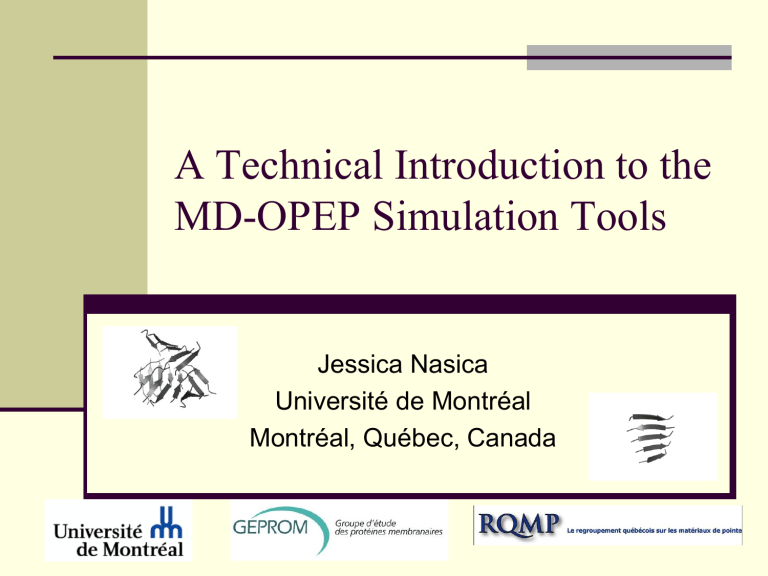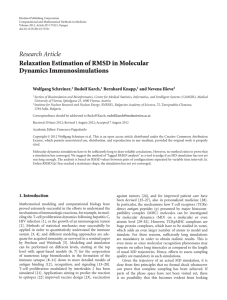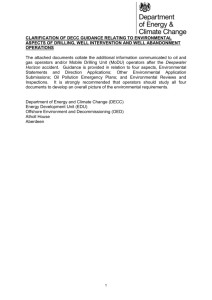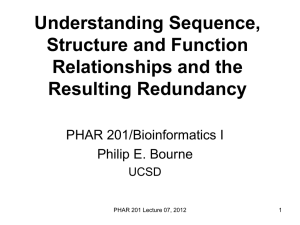A Technical Introduction to the OPEP

A Technical Introduction to the
MD-OPEP Simulation Tools
Jessica Nasica
Universit é de Montréal
Montr éal, Québec, Canada
Outline
Overview of the simulation method
Why use “simulator”?
The OPEP force-field
Running the simulation: what you need to get started
The simulation step by step
The output of the “simulator”
The analysis tools
The PTWHAM analysis
The RMSD analysis
Secondary structure tools
Contacts tools
Clustering tools
Graphical tools and various useful scripts
The simulation method
REMD simulation ( Replica Exchange
Molecular Dynamics )
A simplified coarse-grained potential: OPEP
Why use “simulator”?
It can be used:
To study aggregation processes
To check for the stability of a particular molecular assembly
The simplified force-field allows to reach bigger time scales more efficiently:
To study long-range proteins motions
To extract accurate thermodynamics properties
P. Derreumaux, N. Mousseau – J. Chem. Phys. 126 , 025101 (2007)
The OPEP force-field
OPEP = Optimized Potential for
Efficient structure Prediction
Reduced-protein model:
A 6-particle model with a detailed representation of the backbone (except for
Proline)
Each side chain is represented as one particle and defined by one centroid
Implicit solvent solvent effects included in the interaction parameters
Maupetit et al.
- Proteins 2007; 69 :394-408
/
Chebaro et al.
– J. Phys. Chem. B 2008
The OPEP force-field
OPEP energy function:
E
E local
Local Forces:
E nonbonded
E
H
bond
Includes changes in bond lengths and valence angles for all particles and changes in improper torsions of the side chains.
Nonbonded Forces:
Van der Waals , electric and hydrophobic forces short- and longrange interactions are computed separately.
Use of a pairwise contact potential between side chains represented either by a 12-6 potential or by a 6-potential.
Hydrogen-bonding Forces:
2 terms 2-body H-bonds
4-body effects = cooperative energies between H-bonds
Maupetit et al.
- Proteins 2007; 69 :394-408
/
Chebaro et al.
– J. Phys. Chem. B 2008
Running the “simulator”
What you need to get started:
The executable file after compilation of the code
The parameter file ‘simulator.sh’
Your ‘.pdb’ file in an OPEP format
The corresponding topology file (.top), residue description file (.list) and ‘ichain.dat’ file
The ‘cutoff.dat’ and ‘scale.dat’ files
A link file and a qsub script
The simulation step by step
Step 1:Minimization: finding a stable starting point
It makes sure that the structure’s energy is minimized using ART.
F on _ each _ atom
0
The 2 phases of ART:
-Activation phase the structure is pushed towards a saddle point
-Relaxation phase the structure is pushed slightly over the saddle point and relaxed to a new local energy minimum
Mousseau et al.
– Frontiers in Bioscience 13 - 2008; 4495-4516
The simulation step by step
Step 1:Minimization: the output
The minimized configuration is written in the file “relaxed_conformation.pdb”.
The data resulting from each minimization step is written in “log.file”:
Total Energy .
towards a minimum
Net Force to 0
Decrease in potential energy term
Velocity Rmsd value
Decrease in kinetic energy term
Structure is undergoing a configurational change
The simulation step by step
Step 2: Thermalization:
It thermalizes the configurations by heating up by stages until it reaches the target temperature.
Here, in “simulator.sh”:
E =
T =
-98.5290
0.00 K
Initial conformation
Energies are in Kcal/mol
Relaxed conformation
(from minimization step)
Thermalization conformations
1 5
The simulation step by step
Step 3: MD calculation of forces: using the velocityVerlet algorithm for integrating Newton’s equation of motion for each particle:
F i
m i a i where F i
V r i
, the force on particle i.
(Highly simplified description of MD)
The simulation step by step
Step 4: Writing of the .pdb files:
At each desired time step, the new configuration is written in the
“min” files for each temperature.
Output files
The configurations are sorted by temperature.
Analysis tools
The PTWHAM tool
Allows a temporal correlation in the data, using autocorrelation analysis, to compute equilibrium averages.
we can derive thermodynamical properties , including data from each temperature.
The PTWHAM tool
How to use it:
1)
2)
./ptwham_first
will read data in each pXX/min file, calculate the
Rg, rmsd and end-to-end distance, and output files simXX.txt, wham_parameters.dat, beta.dat
edit wham_parameters.dat
3) ./ptwham_second mintime maxtime
writes “averages.txt” containing U (total energy), rmsd, Cv, end-to-end distance, writes
“free_energies.txt” containing Uk (average energy per replica), free energy and entropy and writes “deviations.txt” containing all the uncertainties on the above observables.
The PTWHAM tool
The output:
Using 2 python scripts, we obtain the following plots:
The RMSD tool
Calculates the rms distance between 2 configurations or between 1 configuration and a list of configurations taking into account their individual clusters for more accuracy.
Recognizes clusters from hydrogen bonds formed using the
DSSP definition of a hydrogen bond: the DSSP algorithm identifies a H-bond if E<-0.5 Kcal/mol.
The program searches all the peptides forming H-bonds and rearranges the pdb file accounting for the chain order in the clusters formed.
How to use it: rmsd conf1.pdb list
It needs “ichain.dat”.
The RMSD tool
-
-
-
The output files are : rmsd.txt containing all the rmsd values for each configuration in the list id_order.txt
containing all the clusters formed for each configuration in the list parallel_planes.txt
containing a list of all the clusters being parallel to each other
The Replicas tool
A python script that generates a graph showing acceptance probability for replica exchange.
Need “log.file” and “replicas.dat”
Additional useful scripts
Pymol scripts allowing to prepare the pdb files and make movies out of the configurations unique_pymol command: unique_pymol file skip
Python scripts:
extract_confs extracts a subset of configurations from a single file containing a list of configurations.
repair_min repairs min files that are broken by a crash, removing all the incorrect lines.
Graphics scripts:
trace_averages.py
( WHAM analysis ) command: ./trace_averages.py “averages.txt” “title” “1”
trace_freeenergies.py
( WHAM analysis ) command: ./trace_freeenergies.py “free_energies.txt”
“title” “1”
Where to find our packages?
You will find an updated version of the analysis tools on the wiki: http://riel.pmc.umontreal.ca/groups/biophysique/








